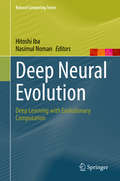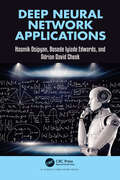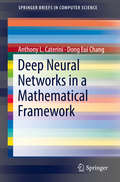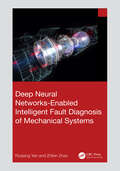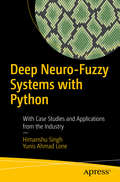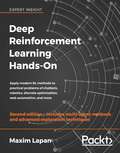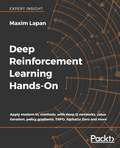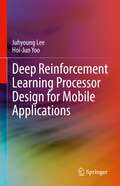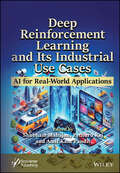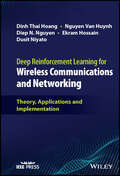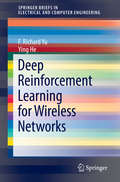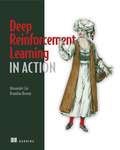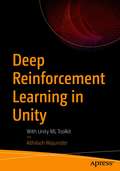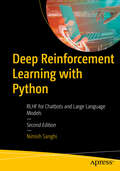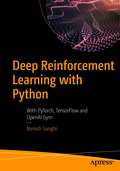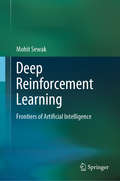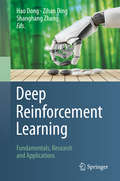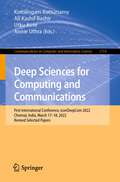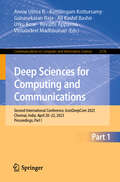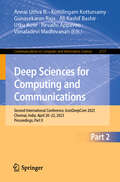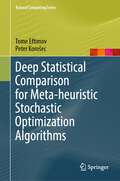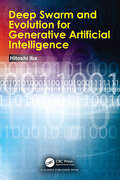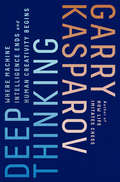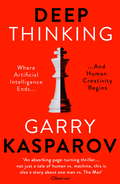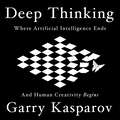- Table View
- List View
Deep Neural Evolution: Deep Learning with Evolutionary Computation (Natural Computing Series)
by Nasimul Noman Hitoshi IbaThis book delivers the state of the art in deep learning (DL) methods hybridized with evolutionary computation (EC). Over the last decade, DL has dramatically reformed many domains: computer vision, speech recognition, healthcare, and automatic game playing, to mention only a few. All DL models, using different architectures and algorithms, utilize multiple processing layers for extracting a hierarchy of abstractions of data. Their remarkable successes notwithstanding, these powerful models are facing many challenges, and this book presents the collaborative efforts by researchers in EC to solve some of the problems in DL. EC comprises optimization techniques that are useful when problems are complex or poorly understood, or insufficient information about the problem domain is available. This family of algorithms has proven effective in solving problems with challenging characteristics such as non-convexity, non-linearity, noise, and irregularity, which dampen the performance of most classic optimization schemes. Furthermore, EC has been extensively and successfully applied in artificial neural network (ANN) research —from parameter estimation to structure optimization. Consequently, EC researchers are enthusiastic about applying their arsenal for the design and optimization of deep neural networks (DNN). This book brings together the recent progress in DL research where the focus is particularly on three sub-domains that integrate EC with DL: (1) EC for hyper-parameter optimization in DNN; (2) EC for DNN architecture design; and (3) Deep neuroevolution. The book also presents interesting applications of DL with EC in real-world problems, e.g., malware classification and object detection. Additionally, it covers recent applications of EC in DL, e.g. generative adversarial networks (GAN) training and adversarial attacks. The book aims to prompt and facilitate the research in DL with EC both in theory and in practice.
Deep Neural Network Applications
by Adrian David Cheok Bosede Iyiade Edwards Hasmik OsipyanThe world is on the verge of fully ushering in the fourth industrial revolution, of which artificial intelligence (AI) is the most important new general-purpose technology. Like the steam engine that led to the widespread commercial use of driving machineries in the industries during the first industrial revolution; the internal combustion engine that gave rise to cars, trucks, and airplanes; electricity that caused the second industrial revolution through the discovery of direct and alternating current; and the Internet, which led to the emergence of the information age, AI is a transformational technology. It will cause a paradigm shift in the way’s problems are solved in every aspect of our lives, and, from it, innovative technologies will emerge. AI is the theory and development of machines that can imitate human intelligence in tasks such as visual perception, speech recognition, decision-making, and human language translation. This book provides a complete overview on the deep learning applications and deep neural network architectures. It also gives an overview on most advanced future-looking fundamental research in deep learning application in artificial intelligence. Research overview includes reasoning approaches, problem solving, knowledge representation, planning, learning, natural language processing, perception, motion and manipulation, social intelligence and creativity. It will allow the reader to gain a deep and broad knowledge of the latest engineering technologies of AI and Deep Learning and is an excellent resource for academic research and industry applications.
Deep Neural Networks in a Mathematical Framework (SpringerBriefs in Computer Science)
by Dong Eui Chang Anthony L. CateriniThis SpringerBrief describes how to build a rigorous end-to-end mathematical framework for deep neural networks. The authors provide tools to represent and describe neural networks, casting previous results in the field in a more natural light. In particular, the authors derive gradient descent algorithms in a unified way for several neural network structures, including multilayer perceptrons, convolutional neural networks, deep autoencoders and recurrent neural networks. Furthermore, the authors developed framework is both more concise and mathematically intuitive than previous representations of neural networks.This SpringerBrief is one step towards unlocking the black box of Deep Learning. The authors believe that this framework will help catalyze further discoveries regarding the mathematical properties of neural networks.This SpringerBrief is accessible not only to researchers, professionals and students working and studying in the field of deep learning, but also to those outside of the neutral network community.
Deep Neural Networks-Enabled Intelligent Fault Diagnosis of Mechanical Systems
by Ruqiang Yan Zhibin ZhaoThe book aims to highlight the potential of deep learning (DL)-enabled methods in intelligent fault diagnosis (IFD), along with their benefits and contributions.The authors first introduce basic applications of DL-enabled IFD, including auto-encoders, deep belief networks, and convolutional neural networks. Advanced topics of DL-enabled IFD are also explored, such as data augmentation, multi-sensor fusion, unsupervised deep transfer learning, neural architecture search, self-supervised learning, and reinforcement learning. Aiming to revolutionize the nature of IFD, Deep Neural Networks-Enabled Intelligent Fault Diangosis of Mechanical Systems contributes to improved efficiency, safety, and reliability of mechanical systems in various industrial domains.The book will appeal to academic researchers, practitioners, and students in the fields of intelligent fault diagnosis, prognostics and health management, and deep learning.
Deep Neuro-Fuzzy Systems with Python: With Case Studies and Applications from the Industry
by Himanshu Singh Yunis Ahmad LoneGain insight into fuzzy logic and neural networks, and how the integration between the two models makes intelligent systems in the current world. This book simplifies the implementation of fuzzy logic and neural network concepts using Python. You’ll start by walking through the basics of fuzzy sets and relations, and how each member of the set has its own membership function values. You’ll also look at different architectures and models that have been developed, and how rules and reasoning have been defined to make the architectures possible. The book then provides a closer look at neural networks and related architectures, focusing on the various issues neural networks may encounter during training, and how different optimization methods can help you resolve them. In the last section of the book you’ll examine the integrations of fuzzy logics and neural networks, the adaptive neuro fuzzy Inference systems, and various approximations related to the same. You’ll review different types of deep neuro fuzzy classifiers, fuzzy neurons, and the adaptive learning capability of the neural networks. The book concludes by reviewing advanced neuro fuzzy models and applications. What You’ll Learn Understand fuzzy logic, membership functions, fuzzy relations, and fuzzy inferenceReview neural networks, back propagation, and optimizationWork with different architectures such as Takagi-Sugeno model, Hybrid model, genetic algorithms, and approximations Apply Python implementations of deep neuro fuzzy system Who This book Is For Data scientists and software engineers with a basic understanding of Machine Learning who want to expand into the hybrid applications of deep learning and fuzzy logic.
Deep Reinforcement Learning Hands-On: Apply modern RL methods to practical problems of chatbots, robotics, discrete optimization, web automation, and more, 2nd Edition
by Maxim LapanNew edition of the bestselling guide to deep reinforcement learning and how it's used to solve complex real-world problems. Revised and expanded to include multi-agent methods, discrete optimization, RL in robotics, advanced exploration techniques, and more Key Features Second edition of the bestselling introduction to deep reinforcement learning, expanded with six new chapters Learn advanced exploration techniques including noisy networks, pseudo-count, and network distillation methods Apply RL methods to cheap hardware robotics platforms Book Description Deep Reinforcement Learning Hands-On, Second Edition is an updated and expanded version of the bestselling guide to the very latest reinforcement learning (RL) tools and techniques. It provides you with an introduction to the fundamentals of RL, along with the hands-on ability to code intelligent learning agents to perform a range of practical tasks. With six new chapters devoted to a variety of up-to-the-minute developments in RL, including discrete optimization (solving the Rubik's Cube), multi-agent methods, Microsoft's TextWorld environment, advanced exploration techniques, and more, you will come away from this book with a deep understanding of the latest innovations in this emerging field. In addition, you will gain actionable insights into such topic areas as deep Q-networks, policy gradient methods, continuous control problems, and highly scalable, non-gradient methods. You will also discover how to build a real hardware robot trained with RL for less than $100 and solve the Pong environment in just 30 minutes of training using step-by-step code optimization. In short, Deep Reinforcement Learning Hands-On, Second Edition, is your companion to navigating the exciting complexities of RL as it helps you attain experience and knowledge through real-world examples. What you will learn Understand the deep learning context of RL and implement complex deep learning models Evaluate RL methods including cross-entropy, DQN, actor-critic, TRPO, PPO, DDPG, D4PG, and others Build a practical hardware robot trained with RL methods for less than $100 Discover Microsoft's TextWorld environment, which is an interactive fiction games platform Use discrete optimization in RL to solve a Rubik's Cube Teach your agent to play Connect 4 using AlphaGo Zero Explore the very latest deep RL research on topics including AI chatbots Discover advanced exploration techniques, including noisy networks and network distillation techniques Who this book is for Some fluency in Python is assumed. Sound understanding of the fundamentals of deep learning will be helpful. This book is an introduction to deep RL and requires no background in RL
Deep Reinforcement Learning Hands-On: Apply modern RL methods, with deep Q-networks, value iteration, policy gradients, TRPO, AlphaGo Zero and more
by Maxim LapanThis practical guide will teach you how deep learning (DL) can be used to solve complex real-world problems. Key Features Explore deep reinforcement learning (RL), from the first principles to the latest algorithms Evaluate high-profile RL methods, including value iteration, deep Q-networks, policy gradients, TRPO, PPO, DDPG, D4PG, evolution strategies and genetic algorithms Keep up with the very latest industry developments, including AI-driven chatbotsBook DescriptionRecent developments in reinforcement learning (RL), combined with deep learning (DL), have seen unprecedented progress made towards training agents to solve complex problems in a human-like way. Google’s use of algorithms to play and defeat the well-known Atari arcade games has propelled the field to prominence, and researchers are generating new ideas at a rapid pace. Deep Reinforcement Learning Hands-On is a comprehensive guide to the very latest DL tools and their limitations. You will evaluate methods including Cross-entropy and policy gradients, before applying them to real-world environments. Take on both the Atari set of virtual games and family favorites such as Connect4. The book provides an introduction to the basics of RL, giving you the know-how to code intelligent learning agents to take on a formidable array of practical tasks. Discover how to implement Q-learning on ‘grid world’ environments, teach your agent to buy and trade stocks, and find out how natural language models are driving the boom in chatbots.What you will learn Understand the DL context of RL and implement complex DL models Learn the foundation of RL: Markov decision processes Evaluate RL methods including Cross-entropy, DQN, Actor-Critic, TRPO, PPO, DDPG, D4PG and others Discover how to deal with discrete and continuous action spaces in various environments Defeat Atari arcade games using the value iteration method Create your own OpenAI Gym environment to train a stock trading agent Teach your agent to play Connect4 using AlphaGo Zero Explore the very latest deep RL research on topics including AI-driven chatbotsWho this book is forSome fluency in Python is assumed. Basic deep learning (DL) approaches should be familiar to readers and some practical experience in DL will be helpful. This book is an introduction to deep reinforcement learning (RL) and requires no background in RL.
Deep Reinforcement Learning Processor Design for Mobile Applications
by Hoi-Jun Yoo Juhyoung LeeThis book discusses the acceleration of deep reinforcement learning (DRL), which may be the next step in the burst success of artificial intelligence (AI). The authors address acceleration systems which enable DRL on area-limited & battery-limited mobile devices. Methods are described that enable DRL optimization at the algorithm-, architecture-, and circuit-levels of abstraction.
Deep Reinforcement Learning and Its Industrial Use Cases: AI for Real-World Applications
by Pethuru Raj Shubham Mahajan Amit Kant PanditThis book serves as a bridge connecting the theoretical foundations of DRL with practical, actionable insights for implementing these technologies in a variety of industrial contexts, making it a valuable resource for professionals and enthusiasts at the forefront of technological innovation. Deep Reinforcement Learning (DRL) represents one of the most dynamic and impactful areas of research and development in the field of artificial intelligence. Bridging the gap between decision-making theory and powerful deep learning models, DRL has evolved from academic curiosity to a cornerstone technology driving innovation across numerous industries. Its core premise—enabling machines to learn optimal actions within complex environments through trial and error—has broad implications, from automating intricate decision processes to optimizing operations that were previously beyond the reach of traditional AI techniques. “Deep Reinforcement Learning and Its Industrial Use Cases: AI for Real-World Applications” is an essential guide for anyone eager to understand the nexus between cutting-edge artificial intelligence techniques and practical industrial applications. This book not only demystifies the complex theory behind deep reinforcement learning (DRL) but also provides a clear roadmap for implementing these advanced algorithms in a variety of industries to solve real-world problems. Through a careful blend of theoretical foundations, practical insights, and diverse case studies, the book offers a comprehensive look into how DRL is revolutionizing fields such as finance, healthcare, manufacturing, and more, by optimizing decisions in dynamic and uncertain environments. This book distills years of research and practical experience into accessible and actionable knowledge. Whether you’re an AI professional seeking to expand your toolkit, a business leader aiming to leverage AI for competitive advantage, or a student or academic researching the latest in AI applications, this book provides valuable insights and guidance. Beyond just exploring the successes of DRL, it critically examines challenges, pitfalls, and ethical considerations, preparing readers to not only implement DRL solutions but to do so responsibly and effectively. Audience The book will be read by researchers, postgraduate students, and industry engineers in machine learning and artificial intelligence, as well as those in business and industry seeking to understand how DRL can be applied to solve complex industry-specific challenges and improve operational efficiency.
Deep Reinforcement Learning for Wireless Communications and Networking: Theory, Applications and Implementation
by Dusit Niyato Ekram Hossain Dinh Thai Hoang Nguyen Van Huynh Diep N. NguyenDeep Reinforcement Learning for Wireless Communications and Networking Comprehensive guide to Deep Reinforcement Learning (DRL) as applied to wireless communication systems Deep Reinforcement Learning for Wireless Communications and Networking presents an overview of the development of DRL while providing fundamental knowledge about theories, formulation, design, learning models, algorithms and implementation of DRL together with a particular case study to practice. The book also covers diverse applications of DRL to address various problems in wireless networks, such as caching, offloading, resource sharing, and security. The authors discuss open issues by introducing some advanced DRL approaches to address emerging issues in wireless communications and networking. Covering new advanced models of DRL, e.g., deep dueling architecture and generative adversarial networks, as well as emerging problems considered in wireless networks, e.g., ambient backscatter communication, intelligent reflecting surfaces and edge intelligence, this is the first comprehensive book studying applications of DRL for wireless networks that presents the state-of-the-art research in architecture, protocol, and application design. Deep Reinforcement Learning for Wireless Communications and Networking covers specific topics such as: Deep reinforcement learning models, covering deep learning, deep reinforcement learning, and models of deep reinforcement learning Physical layer applications covering signal detection, decoding, and beamforming, power and rate control, and physical-layer security Medium access control (MAC) layer applications, covering resource allocation, channel access, and user/cell association Network layer applications, covering traffic routing, network classification, and network slicing With comprehensive coverage of an exciting and noteworthy new technology, Deep Reinforcement Learning for Wireless Communications and Networking is an essential learning resource for researchers and communications engineers, along with developers and entrepreneurs in autonomous systems, who wish to harness this technology in practical applications.
Deep Reinforcement Learning for Wireless Networks (SpringerBriefs in Electrical and Computer Engineering)
by Ying He F. Richard YuThis Springerbrief presents a deep reinforcement learning approach to wireless systems to improve system performance. Particularly, deep reinforcement learning approach is used in cache-enabled opportunistic interference alignment wireless networks and mobile social networks. Simulation results with different network parameters are presented to show the effectiveness of the proposed scheme. There is a phenomenal burst of research activities in artificial intelligence, deep reinforcement learning and wireless systems. Deep reinforcement learning has been successfully used to solve many practical problems. For example, Google DeepMind adopts this method on several artificial intelligent projects with big data (e.g., AlphaGo), and gets quite good results.. Graduate students in electrical and computer engineering, as well as computer science will find this brief useful as a study guide. Researchers, engineers, computer scientists, programmers, and policy makers will also find this brief to be a useful tool.
Deep Reinforcement Learning in Action
by Brandon Brown Alexander ZaiSummary Humans learn best from feedback—we are encouraged to take actions that lead to positive results while deterred by decisions with negative consequences. This reinforcement process can be applied to computer programs allowing them to solve more complex problems that classical programming cannot. Deep Reinforcement Learning in Action teaches you the fundamental concepts and terminology of deep reinforcement learning, along with the practical skills and techniques you&’ll need to implement it into your own projects. Purchase of the print book includes a free eBook in PDF, Kindle, and ePub formats from Manning Publications. About the technology Deep reinforcement learning AI systems rapidly adapt to new environments, a vast improvement over standard neural networks. A DRL agent learns like people do, taking in raw data such as sensor input and refining its responses and predictions through trial and error. About the book Deep Reinforcement Learning in Action teaches you how to program AI agents that adapt and improve based on direct feedback from their environment. In this example-rich tutorial, you&’ll master foundational and advanced DRL techniques by taking on interesting challenges like navigating a maze and playing video games. Along the way, you&’ll work with core algorithms, including deep Q-networks and policy gradients, along with industry-standard tools like PyTorch and OpenAI Gym. What's inside Building and training DRL networks The most popular DRL algorithms for learning and problem solving Evolutionary algorithms for curiosity and multi-agent learning All examples available as Jupyter Notebooks About the reader For readers with intermediate skills in Python and deep learning. About the author Alexander Zai is a machine learning engineer at Amazon AI. Brandon Brown is a machine learning and data analysis blogger. Table of Contents PART 1 - FOUNDATIONS 1. What is reinforcement learning? 2. Modeling reinforcement learning problems: Markov decision processes 3. Predicting the best states and actions: Deep Q-networks 4. Learning to pick the best policy: Policy gradient methods 5. Tackling more complex problems with actor-critic methods PART 2 - ABOVE AND BEYOND 6. Alternative optimization methods: Evolutionary algorithms 7. Distributional DQN: Getting the full story 8.Curiosity-driven exploration 9. Multi-agent reinforcement learning 10. Interpretable reinforcement learning: Attention and relational models 11. In conclusion: A review and roadmap
Deep Reinforcement Learning in Unity: With Unity ML Toolkit
by Abhilash MajumderGain an in-depth overview of reinforcement learning for autonomous agents in game development with Unity.This book starts with an introduction to state-based reinforcement learning algorithms involving Markov models, Bellman equations, and writing custom C# code with the aim of contrasting value and policy-based functions in reinforcement learning. Then, you will move on to path finding and navigation meshes in Unity, setting up the ML Agents Toolkit (including how to install and set up ML agents from the GitHub repository), and installing fundamental machine learning libraries and frameworks (such as Tensorflow). You will learn about: deep learning and work through an introduction to Tensorflow for writing neural networks (including perceptron, convolution, and LSTM networks), Q learning with Unity ML agents, and porting trained neural network models in Unity through the Python-C# API. You will also explore the OpenAI Gym Environment used throughout the book.Deep Reinforcement Learning in Unity provides a walk-through of the core fundamentals of deep reinforcement learning algorithms, especially variants of the value estimation, advantage, and policy gradient algorithms (including the differences between on and off policy algorithms in reinforcement learning). These core algorithms include actor critic, proximal policy, and deep deterministic policy gradients and its variants. And you will be able to write custom neural networks using the Tensorflow and Keras frameworks. Deep learning in games makes the agents learn how they can perform better and collect their rewards in adverse environments without user interference. The book provides a thorough overview of integrating ML Agents with Unity for deep reinforcement learning.What You Will Learn Understand how deep reinforcement learning works in gamesGrasp the fundamentals of deep reinforcement learning Integrate these fundamentals with the Unity ML Toolkit SDKGain insights into practical neural networks for training Agent Brain in the context of Unity ML AgentsCreate different models and perform hyper-parameter tuningUnderstand the Brain-Academy architecture in Unity ML AgentsUnderstand the Python-C# API interface during real-time training of neural networksGrasp the fundamentals of generic neural networks and their variants using TensorflowCreate simulations and visualize agents playing games in Unity Who This Book Is ForReaders with preliminary programming and game development experience in Unity, and those with experience in Python and a general idea of machine learning
Deep Reinforcement Learning with Python: RLHF for Chatbots and Large Language Models
by Nimish SanghiGain a theoretical understanding to the most popular libraries in deep reinforcement learning (deep RL). This new edition focuses on the latest advances in deep RL using a learn-by-coding approach, allowing readers to assimilate and replicate the latest research in this field. New agent environments ranging from games, and robotics to finance are explained to help you try different ways to apply reinforcement learning. A chapter on multi-agent reinforcement learning covers how multiple agents compete, while another chapter focuses on the widely used deep RL algorithm, proximal policy optimization (PPO). You'll see how reinforcement learning with human feedback (RLHF) has been used by chatbots, built using Large Language Models, e.g. ChatGPT to improve conversational capabilities.You'll also review the steps for using the code on multiple cloud systems and deploying models on platforms such as Hugging Face Hub. The code is in Jupyter Notebook, which canbe run on Google Colab, and other similar deep learning cloud platforms, allowing you to tailor the code to your own needs. Whether it’s for applications in gaming, robotics, or Generative AI, Deep Reinforcement Learning with Python will help keep you ahead of the curve.What You'll LearnExplore Python-based RL libraries, including StableBaselines3 and CleanRL Work with diverse RL environments like Gymnasium, Pybullet, and Unity MLUnderstand instruction finetuning of Large Language Models using RLHF and PPOStudy training and optimization techniques using HuggingFace, Weights and Biases, and Optuna Who This Book Is ForSoftware engineers and machine learning developers eager to sharpen their understanding of deep RL and acquire practical skills in implementing RL algorithms fromscratch.
Deep Reinforcement Learning with Python: With PyTorch, TensorFlow and OpenAI Gym
by Nimish SanghiDeep reinforcement learning is a fast-growing discipline that is making a significant impact in fields of autonomous vehicles, robotics, healthcare, finance, and many more. This book covers deep reinforcement learning using deep-q learning and policy gradient models with coding exercise.You'll begin by reviewing the Markov decision processes, Bellman equations, and dynamic programming that form the core concepts and foundation of deep reinforcement learning. Next, you'll study model-free learning followed by function approximation using neural networks and deep learning. This is followed by various deep reinforcement learning algorithms such as deep q-networks, various flavors of actor-critic methods, and other policy-based methods. You'll also look at exploration vs exploitation dilemma, a key consideration in reinforcement learning algorithms, along with Monte Carlo tree search (MCTS), which played a key role in the success of AlphaGo. The final chapters conclude with deep reinforcement learning implementation using popular deep learning frameworks such as TensorFlow and PyTorch. In the end, you'll understand deep reinforcement learning along with deep q networks and policy gradient models implementation with TensorFlow, PyTorch, and Open AI Gym.What You'll LearnExamine deep reinforcement learning Implement deep learning algorithms using OpenAI’s Gym environmentCode your own game playing agents for Atari using actor-critic algorithmsApply best practices for model building and algorithm training Who This Book Is ForMachine learning developers and architects who want to stay ahead of the curve in the field of AI and deep learning.
Deep Reinforcement Learning: Frontiers of Artificial Intelligence
by Mohit SewakThis book starts by presenting the basics of reinforcement learning using highly intuitive and easy-to-understand examples and applications, and then introduces the cutting-edge research advances that make reinforcement learning capable of out-performing most state-of-art systems, and even humans in a number of applications. The book not only equips readers with an understanding of multiple advanced and innovative algorithms, but also prepares them to implement systems such as those created by Google Deep Mind in actual code. This book is intended for readers who want to both understand and apply advanced concepts in a field that combines the best of two worlds – deep learning and reinforcement learning – to tap the potential of ‘advanced artificial intelligence’ for creating real-world applications and game-winning algorithms.
Deep Reinforcement Learning: Fundamentals, Research and Applications
by Hao Dong Zihan Ding Shanghang ZhangDeep reinforcement learning (DRL) is the combination of reinforcement learning (RL) and deep learning. It has been able to solve a wide range of complex decision-making tasks that were previously out of reach for a machine, and famously contributed to the success of AlphaGo. Furthermore, it opens up numerous new applications in domains such as healthcare, robotics, smart grids and finance. Divided into three main parts, this book provides a comprehensive and self-contained introduction to DRL. The first part introduces the foundations of deep learning, reinforcement learning (RL) and widely used deep RL methods and discusses their implementation. The second part covers selected DRL research topics, which are useful for those wanting to specialize in DRL research. To help readers gain a deep understanding of DRL and quickly apply the techniques in practice, the third part presents mass applications, such as the intelligent transportation system and learning to run, with detailed explanations. The book is intended for computer science students, both undergraduate and postgraduate, who would like to learn DRL from scratch, practice its implementation, and explore the research topics. It also appeals to engineers and practitioners who do not have strong machine learning background, but want to quickly understand how DRL works and use the techniques in their applications.
Deep Sciences for Computing and Communications: First International Conference, IconDeepCom 2022, Chennai, India, March 17–18, 2022, Revised Selected Papers (Communications in Computer and Information Science #1719)
by Utku Kose Ali Kashif Bashir Kottilingam Kottursamy Annie UthraThis book constitutes selected papers presented during the First International Conference on Deep Sciences for Computing and Communications, IconDeepCom 2022, held in Chennai, India, in March 2022.The 27 papers presented were thoroughly reviewed and selected from 97 submissions. They are organized in topical sections as follows: classification and regression problems for communication paradigms; deep learning and vision computing; deep- recurrent neural network (RNN) for industrial informatics; extended AI for heterogeneous edge.
Deep Sciences for Computing and Communications: Second International Conference, IconDeepCom 2023, Chennai, India, April 20–22, 2023, Proceedings, Part I (Communications in Computer and Information Science #2176)
by Utku Kose Ali Kashif Bashir Kottilingam Kottursamy Annie Uthra R. Gunasekaran Raja Revathi Appavoo Vimaladevi MadhivananThis two-volume set, CCIS 2176-2177, constitutes the proceedings from the Second International Conference on Deep Sciences for Computing and Communications, IconDeepCom 2023, held in Chennai, India, in April 2023. The 74 full papers and 8 short papers presented here were thoroughly reviewed and selected from 252 submissions. The papers presented in these two volumes are organized in the following topical sections: Part I: Applications of Block chain for Digital Landscape; Deep Learning approaches for Multipotent Application; Machine Learning Techniques for Intelligent Applications; Industrial use cases of IOT; NLP for Linguistic Support; Convolution Neural Network for Vision Applications. Part II: Optimized Wireless Sensor Network Protocols; Cryptography Applications for Enhanced Security; Implications of Networking on Society; Deep Learning Model for Health informatics; Web Application for Connected Communities; Intelligent Insights using Image Processing; Precision Flood Prediction Models.
Deep Sciences for Computing and Communications: Second International Conference, IconDeepCom 2023, Chennai, India, April 20–22, 2023, Proceedings, Part II (Communications in Computer and Information Science #2177)
by Utku Kose Ali Kashif Bashir Kottilingam Kottursamy Annie Uthra R. Gunasekaran Raja Revathi Appavoo Vimaladevi MadhivananThis two-volume set, CCIS 2176-2177, constitutes the proceedings from the Second International Conference on Deep Sciences for Computing and Communications, IconDeepCom 2023, held in Chennai, India, in April 2023. The 74 full papers and 8 short papers presented here were thoroughly reviewed and selected from 252 submissions. The papers presented in these two volumes are organized in the following topical sections: Part I: Applications of Block chain for Digital Landscape; Deep Learning approaches for Multipotent Application; Machine Learning Techniques for Intelligent Applications; Industrial use cases of IOT; NLP for Linguistic Support; Convolution Neural Network for Vision Applications. Part II: Optimized Wireless Sensor Network Protocols; Cryptography Applications for Enhanced Security; Implications of Networking on Society; Deep Learning Model for Health informatics; Web Application for Connected Communities; Intelligent Insights using Image Processing; Precision Flood Prediction Models.
Deep Statistical Comparison for Meta-heuristic Stochastic Optimization Algorithms (Natural Computing Series)
by Peter Korošec Tome EftimovFocusing on comprehensive comparisons of the performance of stochastic optimization algorithms, this book provides an overview of the current approaches used to analyze algorithm performance in a range of common scenarios, while also addressing issues that are often overlooked. In turn, it shows how these issues can be easily avoided by applying the principles that have produced Deep Statistical Comparison and its variants. The focus is on statistical analyses performed using single-objective and multi-objective optimization data. At the end of the book, examples from a recently developed web-service-based e-learning tool (DSCTool) are presented. The tool provides users with all the functionalities needed to make robust statistical comparison analyses in various statistical scenarios.The book is intended for newcomers to the field and experienced researchers alike. For newcomers, it covers the basics of optimization and statistical analysis, familiarizing them with the subject matter before introducing the Deep Statistical Comparison approach. Experienced researchers can quickly move on to the content on new statistical approaches. The book is divided into three parts:Part I: Introduction to optimization, benchmarking, and statistical analysis – Chapters 2-4.Part II: Deep Statistical Comparison of meta-heuristic stochastic optimization algorithms – Chapters 5-7.Part III: Implementation and application of Deep Statistical Comparison – Chapter 8.
Deep Swarm and Evolution for Generative Artificial Intelligence
by Hitoshi IbaThis book provides theoretical and practical knowledge about swarm and evolutionary approach of generative AI and Large Language Models (LLMs). The development of such tools contributes to better optimizing methodologies with the integration of several machinelearning and deep learning techniques. In particular, it discusses how the “emergence” concept can contribute to the improvement of AI.The book aims to model human cognitive f unction in terms of “emergence” and to explain the feasibility of AI. To this end, it focuses on human perceptions of “utility.” It describes the emergence of various cognitive errors, and irrational behaviours in the multiobjective situations. It also reviews the cognitive differences and similarities between humans and LLMs. Such studies are important when applying LLMs to real-world tasks that involve human cognition, e.g., financial engineering and market issues.The book describes the intelligent behaviour of living organisms. This is to clarify how to achieve AI in the direction of artificial life. It describes sexual selection, which is a well-known natural phenomenon that troubled Darwin, i.e., why evolutionarily useless items evolved such as peacock feathers and moose antlers etc. The book shows how sexual selection is extended as “novelty search” for the application of generative AI, i.e., the image generation with diffusion model. Real-world applications are emphasised. Empirical examples from real-world data show how the concept of deep swarm and evolution is successfully applied when addressing tasks from such recent fields as robotics, e-commerce Web Shop and image generation etc.
Deep Thinking: Where Machine Intelligence Ends and Human Creativity Begins
by Garry Kasparov Mig GreengardGarry Kasparov's 1997 chess match against the IBM supercomputer Deep Blue was a watershed moment in the history of technology. It was the dawn of a new era in artificial intelligence: a machine capable of beating the reigning human champion at this most cerebral game. That moment was more than a century in the making, and in this breakthrough book, Kasparov reveals his astonishing side of the story for the first time. He describes how it felt to strategize against an implacable, untiring opponent with the whole world watching, and recounts the history of machine intelligence through the microcosm of chess, considered by generations of scientific pioneers to be a key to unlocking the secrets of human and machine cognition. Kasparov uses his unrivaled experience to look into the future of intelligent machines and sees it bright with possibility. As many critics decry artificial intelligence as a menace, particularly to human jobs, Kasparov shows how humanity can rise to new heights with the help of our most extraordinary creations, rather than fear them. Deep Thinking is a tightly argued case for technological progress, from the man who stood at its precipice with his own career at stake.
Deep Thinking: Where Machine Intelligence Ends and Human Creativity Begins
by Garry KasparovIn May 1997, the world watched as Garry Kasparov, the greatest chess player in the world, was defeated for the first time by the IBM supercomputer Deep Blue. It was a watershed moment in the history of technology: machine intelligence had arrived at the point where it could best human intellect.It wasn't a coincidence that Kasparov became the symbol of man's fight against the machines. Chess has long been the fulcrum in development of machine intelligence; the hoax automaton 'The Turk' in the 18th century and Alan Turing's first chess program in 1952 were two early examples of the quest for machines to think like humans -- a talent we measured by their ability to beat their creators at chess. As the pre-eminent chessmaster of the 80s and 90s, it was Kasparov's blessing and his curse to play against each generation's strongest computer champions, contributing to their development and advancing the field. Like all passionate competitors, Kasparov has taken his defeat and learned from it. He has devoted much energy to devising ways in which humans can partner with machines in order to produce results better than either can achieve alone. During the twenty years since playing Deep Blue, he's played both with and against machines, learning a great deal about our vital relationship with our most remarkable creations. Ultimately, he's become convinced that by embracing the competition between human and machine intelligence, we can spend less time worrying about being replaced and more thinking of new challenges to conquer.In this breakthrough book, Kasparov tells his side of the story of Deep Blue for the first time -- what it was like to strategize against an implacable, untiring opponent -- the mistakes he made and the reasons the odds were against him. But more than that, he tells his story of AI more generally, and how he's evolved to embrace it, taking part in an urgent debate with philosophers worried about human values, programmers creating self-learning neural networks, and engineers of cutting edge robotics.
Deep Thinking: Where Machine Intelligence Ends and Human Creativity Begins
by Garry KasparovGarry Kasparov gives his first public account of his landmark 1997 chess match with the IBM supercomputer Deep Blue, and explains why, twenty years later, he's become convinced that artificial intelligence is good for humans.In May 1997, the world watched as Garry Kasparov, the greatest chess player in the world, was defeated for the first time by the IBM supercomputer Deep Blue. It was a watershed moment in the history of technology: machine intelligence had arrived at the point where it could best human intellect.It wasn't a coincidence that Kasparov became the symbol of man's fight against the machines. Chess has long been the fulcrum in development of machine intelligence; the hoax automaton 'The Turk' in the 18th century and Alan Turing's first chess program in 1952 were two early examples of the quest for machines to think like humans - a talent we measured by their ability to beat their creators at chess. As the pre-eminent chessmaster of the 80s and 90s, it was Kasparov's blessing and his curse to play against each generation's strongest computer champions, contributing to their development and advancing the field. Like all passionate competitors, Kasparov has taken his defeat and learned from it. He has devoted much energy to devising ways in which humans can partner with machines in order to produce results better than either can achieve alone. During the twenty years since playing Deep Blue, he's played both with and against machines, learning a great deal about our vital relationship with our most remarkable creations. Ultimately, he's become convinced that by embracing the competition between human and machine intelligence, we can spend less time worrying about being replaced and more thinking of new challenges to conquer.In this breakthrough book, Kasparov tells his side of the story of Deep Blue for the first time - what it was like to strategize against an implacable, untiring opponent - the mistakes he made and the reasons the odds were against him. But more than that, he tells his story of AI more generally, and how he's evolved to embrace it, taking part in an urgent debate with philosophers worried about human values, programmers creating self-learning neural networks, and engineers of cutting edge robotics.(P)2017 Hachette Audio
